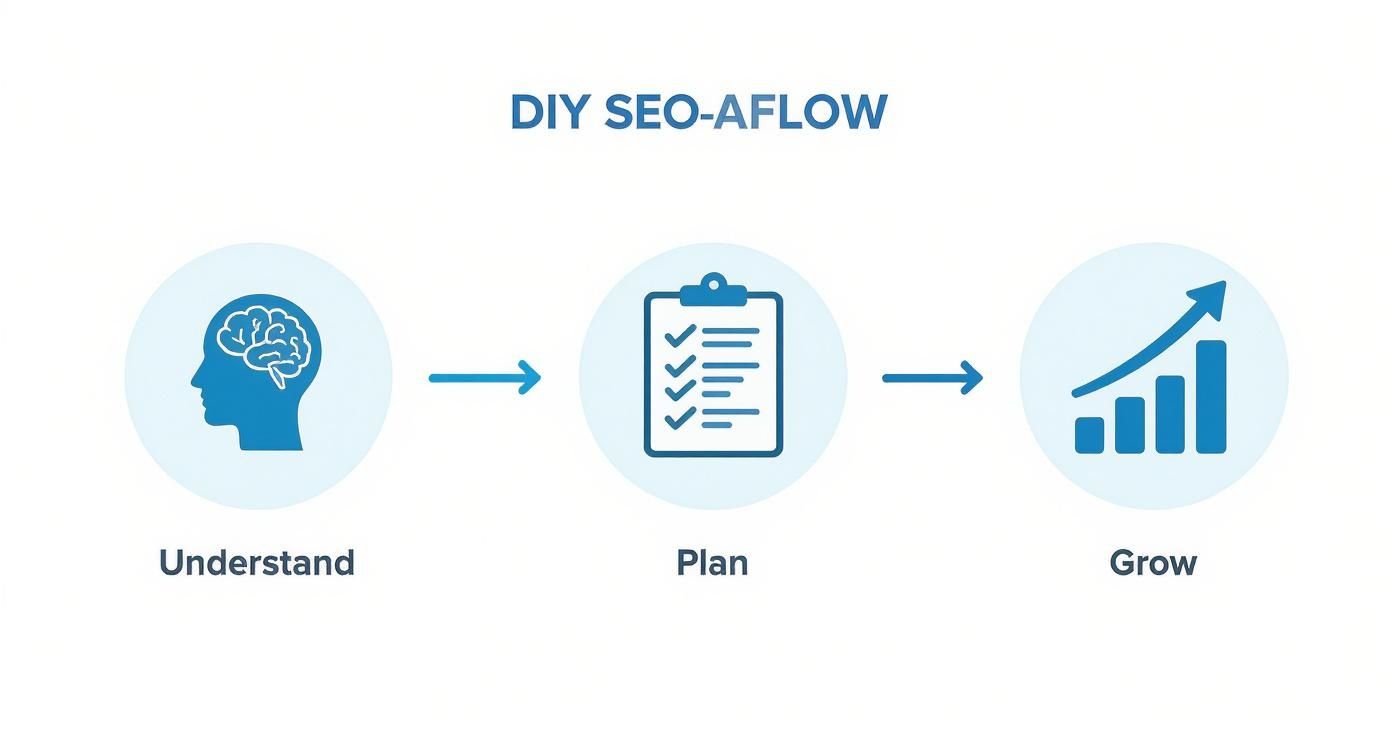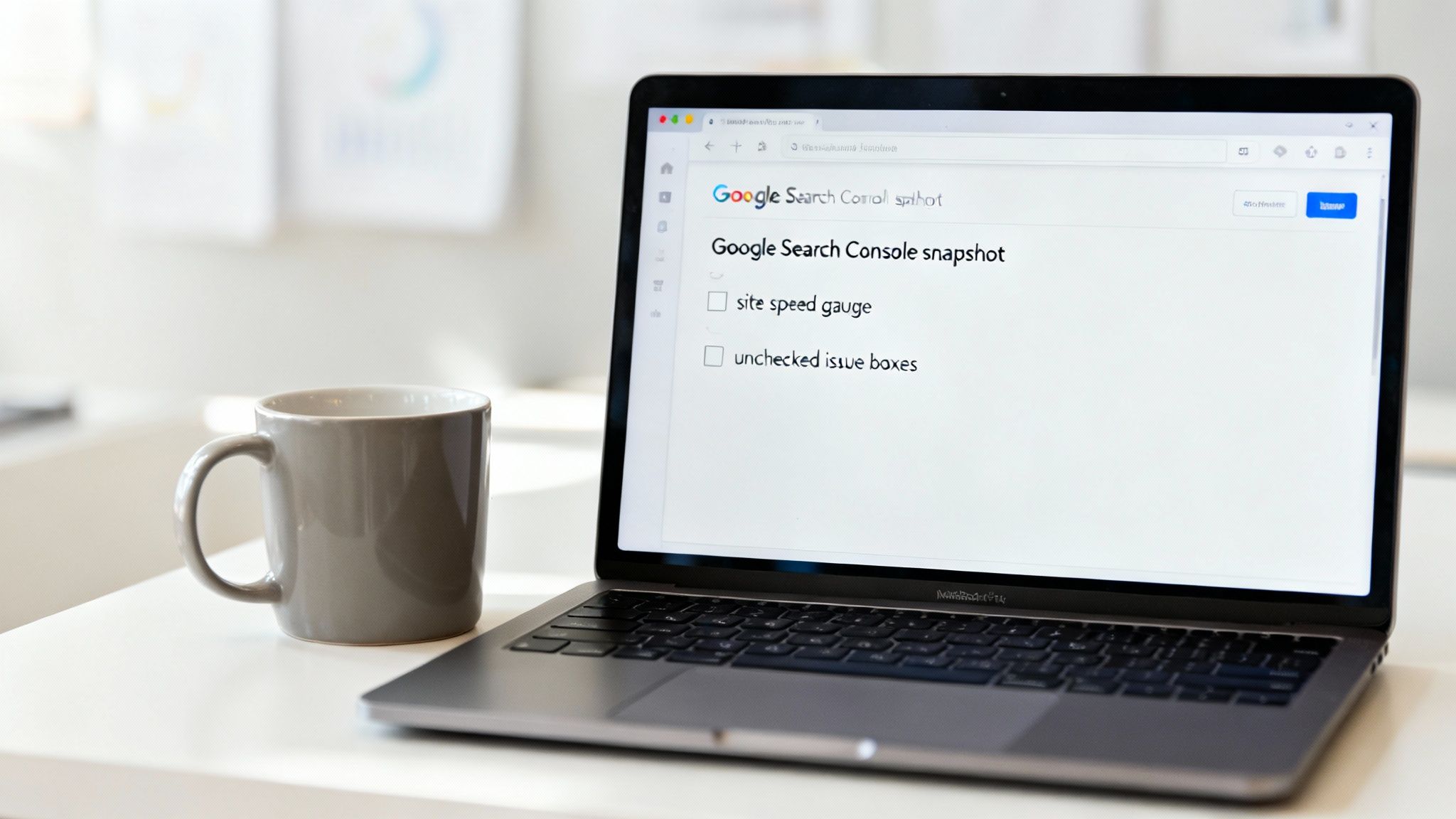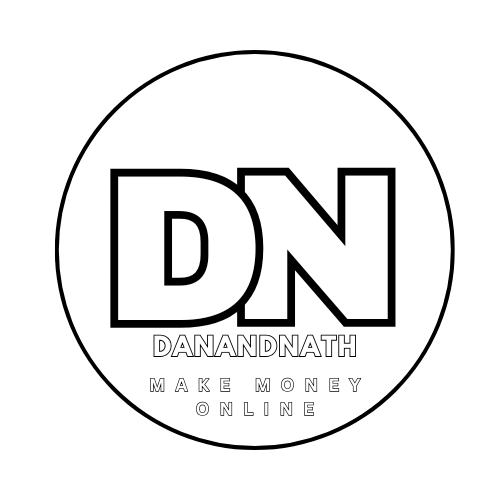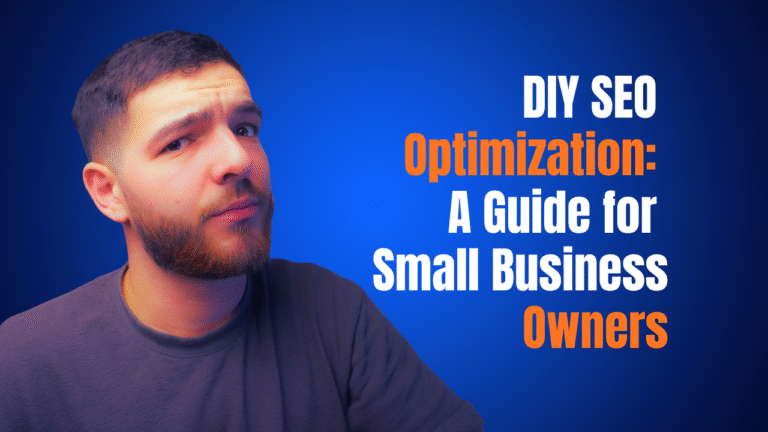Doing your own SEO sounds intimidating, right? I think most people hear “SEO” and picture a team of tech wizards in a dark room, surrounded by complex code. It’s a common misconception.
But here’s the thing: DIY SEO optimization isn’t about that. It’s a hands-on approach where you use simple, consistent tweaks and mostly free tools to get your website seen by the right people. Forget expensive agencies for a minute. This is about steady growth, driven by the one person who knows your business best: you.
Why You Should Tackle Your Own SEO
Jumping into DIY SEO optimization feels like a massive task, but honestly, it’s more achievable for small business owners and creators than you might think. I find the biggest hurdle for most people is just getting started. It’s that initial inertia.
The core idea isn’t about outsmarting Google’s complex algorithms. It’s about making consistent, intelligent changes so search engines understand what you offer. More importantly, it’s about ensuring they show your website to people who are actively looking for it. Simple, right?
And let’s be real—nobody understands your customers, their questions, and their pain points better than you do. That’s a massive advantage you have over any outside agency. I’ve always believed that.
Setting Realistic Expectations
I’m not going to sit here and tell you you’ll hit the #1 spot on Google for a hyper-competitive keyword overnight. That’s not the goal, and frankly, it’s a recipe for disappointment. A real human wouldn’t promise that.
What we’re aiming for is steady, meaningful growth. The kind that brings qualified traffic to your site—people who are genuinely looking for what you sell or have to say.
The whole process, from figuring out where you stand today to celebrating your wins down the line, follows a pretty simple flow.

This just breaks it down into three phases: understanding where you are now, planning your next moves, and then actually seeing your efforts pay off with real growth. It’s not magic; it’s a process. A slightly messy, human process.
A Simple Framework for Success
To turn what can feel like a chaotic task into a clear, manageable plan, we’re going to follow a straightforward six-part framework in this guide. Think of it as your roadmap. It breaks everything down into logical stages so you always know what to focus on next without feeling overwhelmed.
Here’s a quick overview of the essential stages we’ll cover to improve your website’s visibility.
The Six Pillars of Your DIY SEO Strategy
| Stage | Core Focus | Its Impact on Your Business |
|---|---|---|
| Audit | Performing a health check on your website. | Identifies technical issues that are holding you back right now. |
| Keywords | Finding the phrases your customers use. | Ensures you’re creating content people are actually searching for. |
| On-Page | Optimising individual pages on your site. | Tells Google exactly what each page is about, improving relevance. |
| Content | Creating helpful blog posts and guides. | Builds trust, attracts visitors, and establishes your authority. |
| Links | Earning mentions from other websites. | Acts as a “vote of confidence” that boosts your site’s credibility. |
| Tracking | Measuring what’s working (and what isn’t). | Provides proof of your progress and helps you make smarter decisions. |
Each of these pillars builds on the last, creating a solid foundation that will support your website’s growth for years to come. Now, let’s get into the details.
Step 1: Your First Website Health Check (The Audit)
Before you start messing with anything, you need a clear picture of where you stand. Think of this as a quick health check for your site, a baseline SEO audit to see what’s actually going on. We’re not diving into dense technical jargon here. It’s about using a couple of free, incredibly powerful tools to get a real look behind the scenes.
Honestly, skipping this part is like trying to navigate a new city without a map. You might get somewhere eventually. But you’ll probably take a few wrong turns and waste a lot of time. This initial audit informs every single thing we’ll do from here on out.
Getting Set Up With the Essentials
First up, you need to get your hands on two key tools from Google. Both are free, and they give you a direct line into how Google actually sees your website.
- Google Search Console (GSC): This is your direct communication channel with Google. It tells you which pages are indexed, flags any errors stopping your site from being seen, and even shows you the keywords people are using to find you. It’s an absolute non-negotiable for anyone serious about DIY SEO.
- Google Analytics (GA4): This tool is all about your visitors. It shows you how people get to your site, what they do once they arrive, and how long they stick around. It’s crucial for understanding how real people interact with your content.
Setting them up can feel a bit fiddly the first time you do it. I remember getting stuck myself. If you’re not sure how to connect them, we’ve got a video on our YouTube channel, @aussieaffiliatetwins, that walks you through the whole process, step-by-step.
The Low-Hanging Fruit Checklist
Once you’re all set up, the goal isn’t to become a technical wizard overnight. It’s about spotting the easy fixes—the obvious issues that could be holding you back right now.
Start by digging into Google Search Console for these specific things:
- Check for Indexing Errors: In GSC, head over to the ‘Pages’ report under the ‘Indexing’ section. See any important pages listed as ‘Discovered – currently not indexed’? This is a huge red flag. It means Google knows the page exists but hasn’t bothered to add it to search results. You need to find out why.
- Review Core Web Vitals: This sounds technical, but it’s really just about user experience. The report tells you if your site is slow or clunky for visitors, particularly on mobile. A poor score here can seriously hurt your rankings. Often, this comes down to the platform you’re using; for a deeper look into how your website builder affects this, you can check out our comparison of Webflow vs WordPress performance.
- Look for Manual Actions: This is rare, but you absolutely have to check. A manual action means a human reviewer at Google has penalised your site. If you see one, it’s an all-hands-on-deck situation that needs to be fixed immediately.
Your goal with this first check isn’t to fix everything. It’s to build a prioritised list. What’s the one thing you can fix this week that might actually move the needle? Start there.
This initial diagnosis gives you a solid starting point. It turns the vague idea of “doing SEO” into a concrete list of tasks. Don’t get overwhelmed by all the data. Just focus on finding those one or two obvious problems, and you’re already on the right path.
Step 2: Finding Keywords Your Customers Actually Use
Alright, let’s get into keyword research. This whole part sounds way more technical and intimidating than it really is. I reckon people get bogged down in data and forget the main point: figuring out the exact words and phrases your customers are typing into Google.
We’re going to keep this super practical.
It’s less about drowning in spreadsheets and more about getting inside your customer’s head. What problem are they trying to solve right before they might need you? Your deep knowledge of your own business is your biggest asset here, connecting what you know about your customers to their actual search behaviour. It’s a bit like a treasure hunt, and finding that one perfect keyword feels like a genuine win.

Brainstorming Your Seed List
Before we even touch a tool, just grab a pen and paper or open a blank doc.
Start by jotting down the obvious stuff related to your business. If you’re a plumber in Perth, you’d write down “plumber Perth,” “emergency plumber,” and so on. Easy.
Now, think a little bigger.
- What specific services do you offer? (e.g., “blocked drain repair,” “hot water system installation”)
- What questions do customers always ask you? (e.g., “how much to fix a leaking tap,” “why is my toilet running”)
- What problems do your products or services solve? (e.g., “fix noisy pipes,” “best water filter for home”)
These are your ‘seed’ keywords. They’re the starting point for everything else we’re about to do. Don’t filter yourself at this stage; just get all the ideas down on paper.
The Magic of Long-Tail Keywords
This is where small businesses can really punch above their weight. We’re going to focus heavily on long-tail keywords. These are just longer, more specific search phrases, usually three or more words long.
Think about it. Someone searching for “shoes” is just browsing. But someone searching for “waterproof hiking boots for wide feet” knows exactly what they want. That searcher is way closer to making a purchase. That’s the power of long-tails.
They have lower search volume, sure, but they also have much less competition and much higher intent. For a small business doing DIY SEO optimization, these keywords are absolute gold.
Using Free Tools to Find Keyword Gold
Now that you have your brainstormed list, it’s time to use some free tools to expand it and get real data. You honestly don’t need expensive software to get started.
One of the best places to look is right on the Google search results page. Seriously. Type in one of your seed keywords and just scroll down. Look for the “People also ask” and “Related searches” sections at the bottom. These are literally Google telling you what other things people are searching for. It’s a goldmine of ideas.
You can also use a free tool like Ubersuggest or Google’s own Keyword Planner (you’ll need a Google Ads account, but you don’t have to spend any money). These tools give you an idea of search volume—how many people are searching for a term each month—and a difficulty score. For a deeper dive on finding the right tool, our weekly newsletter often highlights new and useful keyword tools worth checking out.
The goal here is to find that sweet spot: a keyword with decent search volume but low difficulty (KD < 25 is a good starting point). This is how you find terms you can realistically rank for without a massive budget.
This is especially true for local businesses. The way people search is changing, particularly in Australia where ‘near me’ searches have skyrocketed. You can discover more insights about the Australian local SEO landscape on netstripes.com. Finding these hyper-local, specific keywords is a massive opportunity just waiting to be grabbed.
Step 3: Optimizing Your Pages (On-Page SEO)
Alright, you’ve done the hard work and have your keyword list ready to go. Now what?
This is where we get into what’s called “on-page SEO”. Don’t let the name intimidate you. It’s really just about making sure those keywords you found are in all the right places on your website.
Honestly, this is one of the most hands-on parts of the whole DIY SEO process, and it’s where you can often see the needle move pretty quickly. We’re going to walk through the bits that actually matter, without getting bogged down in jargon.
Think of it like organising your shopfront. You want to make it dead obvious for both Google and your visitors what each page is about. These small tweaks are powerful signals.
Crafting Titles and Descriptions that Actually Get Clicks
Your title tag and meta description are the first things anyone sees on Google. They’re your five-second pitch. Getting them right is, in my opinion, one of the most critical parts of this entire thing.
The title tag is that blue, clickable headline. The meta description is the little chunk of text underneath it. Their job isn’t just to tell Google what the page is about; they have to convince a real person to click on your link instead of the nine others staring back at them.
Here’s my simple checklist for a good title tag:
- Lead with your main keyword: Try to get your most important keyword as close to the start as possible. It just seems to help.
- Keep it under 60 characters: Go any longer and Google will likely chop it off, which just looks messy and unprofessional.
- Make it compelling: Don’t just state what it is, add a benefit. Instead of “Dog Grooming Services,” try something like “Gentle Dog Grooming Services | Happy Pups Guaranteed.” See the difference?
For your meta description, you’ve got a bit more room to play with—about 155 characters. This is your chance to expand on the title and really sell the click. A solid meta description clearly explains what the person will find on the page and why it’s worth their time.
Structuring Your Content with Headings
Headings aren’t just for making your text look pretty. They create a logical structure for your content, which is a huge deal for both your readers and the search engines.
Think of it like chapters in a book. Your main page title is the book’s title (that’s your H1 tag). Then you have your main sections (H2 tags) and subsections within those (H3, H4, and so on). You should only ever have one H1 tag per page. It’s the headline, the main topic.
When you’re writing your headings, just make sure to sprinkle in your primary and secondary keywords where it feels natural. The key is natural. Don’t force it. The real goal here is clarity. A well-structured page is easier for Google to understand and, more importantly, easier for your visitors to skim and read.
Don’t Forget About Your Images
Image optimisation is one of those things people tend to gloss over, but it can have a pretty big impact. Slow-loading images are one of the biggest culprits behind sluggish websites, and a slow site will definitely hurt your rankings.
Every single image you upload should be compressed first. There are free online tools that can shrink the file size dramatically without making it look terrible. It’s a tiny step that makes a massive difference to your page speed.
Another quick win is using descriptive alt text. Alt text is just a short description of what’s in the image. It’s what screen readers use for visually impaired users, but Google also reads it to figure out what the image is about. So, instead of an alt text like “image123.jpg,” use something like “golden retriever puppy chewing on a red toy.” It’s a small detail, but in SEO, all these small details add up.
These on-page tweaks are the foundation of good DIY SEO. If you want a handy reference, our free guide has a checklist I personally use for this every single time.
Step 4: Creating Content That Google and Customers Love
Alright, let’s get into the heart of any solid SEO play: the actual content.
Without good, helpful stuff on your site, there’s literally nothing for Google to rank. But don’t let that freak you out. You absolutely do not need to be a professional writer to nail this part. Seriously.
This is all about creating genuinely useful articles that answer the real questions your customers are asking every day. I find the best ideas just come from thinking about a customer’s single biggest problem and writing about that one thing. It’s about taking the knowledge that’s already in your head and turning it into blog posts or guides that build trust, long before someone even considers buying from you.

From Expertise to Helpful Content
Here’s the thing: you already have the raw material. It’s the knowledge you use every single day in your business—the advice you give on the phone, the questions you answer over email, the problems you solve for clients.
Your only job is to get that out of your head and onto the page.
Don’t get caught up in sounding perfect. Just be helpful. If you can explain something to a customer in person, you can write a blog post about it. I promise.
Here’s a dead-simple way to kick things off:
- List 5 common questions you get. Write down the detailed answers to each one. Boom, that’s five potential blog posts right there.
- Think about a common mistake your customers make. Write a short guide on how to avoid it. That’s another piece of content sorted.
- Explain a tricky part of your industry. Break it down into simple terms anyone can get. People absolutely love this kind of stuff.
If you want a deeper look at structuring these ideas, we’ve put together a resource on effective blog post creation that helps turn a basic idea into a polished article. It’s all about creating a simple plan to end that constant ‘what should I write about?’ headache.
Weaving in Keywords Naturally
So, how do we fit those keywords we found earlier into our writing without sounding like a clunky robot?
The key is to write for humans first, then gently edit for Google.
Start by writing your article without thinking about keywords at all. Just focus on being clear, helpful, and getting your thoughts down. Once you’ve got a first draft, go back and see where you can naturally place your main keyword and a few related ones. Usually, this just means slotting your primary keyword into:
- Your main title (the H1).
- The first paragraph, if it feels natural.
- At least one or two subheadings (H2s or H3s).
- A few times throughout the body of the article.
Here’s the most important takeaway: if a sentence sounds forced or awkward because you jammed a keyword in, just take it out. A happy reader who sticks around is a much more powerful signal to Google than clunky keyword stuffing ever will be.
Content Isn’t Just an Afterthought
Putting out consistent, quality content is probably the single most important part of your SEO efforts. It’s not just a box-ticking exercise.
Australian businesses with a documented content strategy see way better results. In fact, a whopping 62% of marketers say that blogs and articles are the most effective type of content for improving their rankings. This really drives home why you need to make content a core part of your DIY SEO work.
Ultimately, great content is what attracts links, keeps visitors on your site longer, and tells Google you’re an authority worth listening to. It’s where you build the relationship that actually leads to a sale.
Step 5: Earning Links the Right Way (Link Building)
Alright, let’s get into link building. This is the bit of DIY SEO optimization that often makes people a bit nervous. It can sound technical, maybe a little sketchy, but honestly, it doesn’t have to be.
The easiest way to think about backlinks is as votes of confidence. When another website links to yours, it’s basically giving Google a nudge and saying, “Hey, this site here has something valuable to say.” The more of these high-quality votes you collect, the more credible your site appears.
We’re going to focus on earning these links the natural, ethical way. This is far more about creating genuine value and building real relationships than trying to game the system. Quality over quantity is absolutely the name of the game.

Start With Your Local Community
For most small businesses, your best opportunities are hiding in plain sight—right in your own backyard. This is the low-hanging fruit of link building, and you’d be surprised how effective it can be.
Think about the local businesses you already know and work with.
- Your suppliers or partners: Do they have a “partners” page on their site? Just shoot them a friendly email and ask for a mention. Most are more than happy to help.
- Local business directories: Make sure you’re listed on your local chamber of commerce site or other community hubs. These are often easy wins and add genuine local authority.
- Sponsor a local event: Chipping in to sponsor a small charity fun run or a school fete will almost always get you a link from their website. It’s a win-win.
This stuff isn’t rocket science. It’s just about being an active, helpful member of your community, both online and off. We actually break down a super simple local link building tactic in a video on our YouTube channel, @aussieaffiliatetwins, that you could probably knock over this afternoon.
Create Something Worth Linking To
The other side of the coin is creating content on your own website that people actually want to share. You can’t just expect people to link to your homepage or a generic service page. It just won’t happen.
The real goal here is to create a unique resource that provides undeniable value. This could be anything, really:
- A ridiculously detailed “how-to” guide that solves a common headache in your industry.
- An original piece of local research, like a survey of local shopping habits.
- A free tool or calculator your audience would find genuinely useful.
I won’t lie, this strategy takes more effort. But a single, well-crafted resource can earn links on autopilot for years. It cements your status as an expert and becomes a real asset for your business.
Building links is a slow burn, not a quick fix. Be patient. Focus on earning one good link at a time, and over a few months, you’ll be surprised at the difference it makes.
For small business owners in Australia doing their own SEO, this effort pays off in a big way. In fact, backlinks show an 81.6% correlation with organic traffic for local search rankings. The data is pretty stark: top-performing businesses average over 35 times more backlinks than those on lower pages, which really shows how critical this is. You can dig into more of these Australian local SEO findings on websitesthatsell.com.au. It just proves that putting in the work to earn links is one of the most powerful things you can do.
Step 6: Tracking Your Progress and Measuring Success
So, you’ve put in all this work. You’ve researched keywords, tweaked your pages, and maybe even written some killer content. But how do you actually know if any of it is working?
This last part is all about tracking, because honestly, without it, you’re just flying blind.
We’re going to circle back to the tools we set up at the very start: Google Analytics and Google Search Console. But don’t worry, we’re not going to get lost in a sea of data. I’ll point you to the exact numbers that matter—the ones that give you a real, tangible sense of progress.
Watching these metrics improve is, I think, the most rewarding part of the entire DIY SEO optimization process. It’s proof.
What to Actually Look At
Instead of getting overwhelmed by a hundred different charts, just focus on these key metrics every month. They will tell you 90% of the story.
- Organic Traffic (from Google Analytics): This is the big one. Is the number of visitors coming from organic search going up over time? A steady upward trend, even a small one, is a huge win. It means your efforts are paying off.
- Top Queries (from Google Search Console): Jump into the ‘Performance’ report. What search terms are you starting to show up for? You’ll often find you’re ranking for keywords you weren’t even targeting. It’s like a little bonus.
- Average Position (from Google Search Console): For your main target keywords, is your average ranking position slowly creeping up? Moving from position 25 to position 15 might not feel like a victory, but believe me, it’s a massive step in the right direction.
Keeping It Simple and Consistent
I find the best approach is to set aside 30 minutes on the first Monday of every month. That’s it.
Just log in, check those key metrics, and jot them down in a simple spreadsheet. Don’t overcomplicate it.
This simple check-in prevents tracking from becoming a chore you dread. Instead, it becomes a quick, motivating routine. It helps you see what’s working, what isn’t, and where you might need to adjust your focus for the next month. There are also plenty of other great apps for small business owners that can help you stay organised and on top of your tasks.
This isn’t about hitting perfection every month. It’s about seeing gradual improvement. A small increase in organic traffic or a slight bump in keyword rankings is tangible proof that what you’re doing is making a real difference.
Ultimately, this step turns your SEO efforts from a series of random tasks into a clear strategy. It gives you the feedback you need to keep going and make smarter decisions down the line.
And honestly, there’s nothing better than seeing that graph tick upwards, knowing you made it happen.
Frequently Asked Questions about DIY SEO
When you’re first diving into the world of DIY SEO optimization, it feels like a million questions pop up. I get it. I’ve been there. Here are a few of the most common ones I hear all the time, along with my honest, from-the-trenches answers.
How Long Does DIY SEO Take to Show Results?
Ah, the million-dollar question. The honest answer? It depends. SEO is a long game, not a lottery ticket. You’re building an asset, not flipping a switch. You might see some small wins in a few weeks—perhaps you’ll start ranking for a super-specific, long-tail keyword you weren’t even aiming for. But for the more competitive terms, the ones that really move the needle, you’re typically looking at 3 to 6 months of consistent effort. And consistent is the key word. Dabbling here and there won’t get you anywhere. It’s a lot like going to the gym; you don’t see results after one workout, but if you stick to the plan, the change is undeniable.
Can I Really Do SEO Myself if I’m Not Technical?
One hundred percent, yes. While the deep end of technical SEO can get pretty nerdy and complex, the fundamentals that drive the biggest results for small businesses are surprisingly straightforward. I’d argue they’re more about common sense and knowing your audience than about writing code. If you’re comfortable updating your own website content on platforms like WordPress, Shopify, or Webflow, you’ve already got the core skills needed. This whole guide is focused on the 20% of actions that get you 80% of the results, and most of that is rooted in great content and smart keywords, not technical wizardry.
What is the Most Important Part of DIY SEO?
If I had to boil it all down to one thing, it’s this: create genuinely helpful content that directly solves a problem or answers a question your ideal customer is typing into Google. It sounds almost too simple, but it’s the one thing so many people get wrong. You can have a technically flawless website, but if your content is bland, generic, or doesn’t actually help anyone, you’re not going to get far. High-quality, user-focused content is the foundation of everything else. It’s what earns links naturally, keeps people on your site, and signals to Google that you’re a genuine authority. Start there. I promise you’ll already be ahead of most of your competition.
Grab the free guide below if you want the full setup. Or join our weekly newsletter—we share a new tool every week.
Aussie Affiliate Twins
https://danandnath.com

